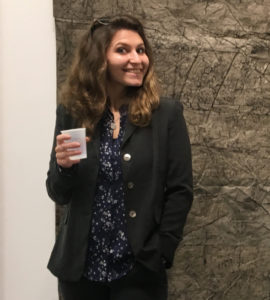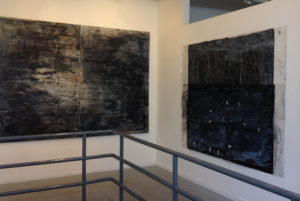Interviews with Artists
In 2017, as part of our ongoing commitment to arts dialogue and education, we began archiving interviews with the artists we have worked with at the Arts Research Collaborative. It is our hope that the collected conversations will continue to be a vital resource for all who visit.
From 2018-2019 UML student Karisa Gaudet worked as an intern and preparator for the ARC. She interviewed Jessica Tawczynski in February 2018.
For people who may be familiar with your earlier work, it appears you have introduced some new elements during your time abroad. I understand that because of the limitations of overseas travel, you made the transition from working on canvas to paper; what effects did that have on your process? Did the shift in materials cause a shift in other areas of your work?
Also, how did the shift in environment affect these works? Are they reflections of Iceland or your experience there?
Working abroad in Iceland led me to working with old materials in new ways; though I have always been a maker of paintings, prints, and works on paper. Iceland has a rich history involving textiles and mirroring landscape and nature into different elements of culture and architecture as well. I wanted to bring some of this way of thinking into the work. The large printed pieces, (For example, “E^vii” that is in the show at ARC) were made by making many smaller prints and collaging them together. Working on paper not only offered me a kind of non-precious route of experimentation but also allowed for this kind of mirroring. The pieces come together to form a sort of topographic network and like the land, seems to be a patchwork of different frames of time. The paper I’m using is a rough but very lightweight one, allowing it to be pulled taught or wrinkled inwards- that creates a flowing kind of movement like a blanket. I thought the language of print and the collage came together into a dialogue with the woven works you so frequently see there as well. The shadows from these “textile print collage” also cast a mountainous horizon onto the wall below them.
In your statement, you say that these works are “mirror of the world we exist and move through but cannot see”, can you elaborate on this idea?
We know the world through interactions. There are things that humans simply cannot sensibly experience. In these works there is a distillation that goes on, revealing those things. We can go on to make a metaphor of those things that deals directly with a human daily experience of the world. For example, “Yesterday was smaller than today” is a comment on the ever expanding universe. We experience the universe growing every day because we live in it and are a part of it, but how do we use our human bodies as a tool to decode that kind of logic?
Can you briefly describe which scientific and philosophical theories inspired this work?
I’ll just list a few of the most influential ideas I’ve been thinking about:
- Particle physics in general is one of the biggest influences in my work right now in terms of scientific ideas.
- Particles cannot be created or destroyed except in pairs, where one is ordinary and the other is an antiparticle… Particle acceleration and researching current work being done at CERN… Higgs Boson particle: granting mass to all other particles. (just to name a few things)
- Philosophy: Deleuze and Guattari’s Theory of the “Rhizome” from their book, “1,000 plateaus”
- Newton’s laws of physics- specifically the third law: for every action, there is an equal and opposite reaction.
- Philosophy: Merleau Ponty’s “Phenomenology of Perception”
- Philosophy: Gaston Bachelard’s “Poetics of Space”
Are there still elements in the recent work that carry over from your time in graduate school?
Graduate school is a time of deep connection and frustration in the studio. It takes you to all of the hourble and wonderful reasons for what you do and why. I think some of that will always be present as well as some of what I have taken with me from my Bachelors at UML. The people you surround yourself with are influential and can challenge you. I feel home grown in Massachusetts. Your upbringing and experience as a young artist sticks with you in that way- I will always characterize a part of what I am doing as a maker with my past.
In terms of some visual language that happens across my recent work, yes some of it has carried over. “Yesterday was smaller than today” was also shown as part of my grad thesis work at MassArt. In grad school I started making these hybrid print/painting works and I’m still very interested in making hybridized two dimensional pieces.
The light in this body of work (from the residency) is different from that of your previous work, why is that?
I am interested in how one perceives the world using their bodies as a tool. This is a direct comment on Merleau Ponty’s Phenomenology of Perception. My earlier works, or the large multiple panel paintings were the first works. I like the idea that the painting forces you to move your body to view it. There is a kind of event taking place that lasts longer than a moment or a glance. The light in the paintings posit an illusionary situation with the physical light of the gallery. The paint creates the illusion and the ink reflects the light of the room. As one moves around the pieces, the reflected light changes and things are uncovered. In the large printed works from Iceland, I wanted to create a soft and subtle illusion in contrast to the stark and sharp reflections. The ink is not only on the surface this time but soaked through and imbedded within the paper. This kind of physicality creates the illusion that the light from the room is the light within the work. It’s interesting to think that light could be a kind of doorway for the viewer to enter the work through. And as an artist who is interested in anthropomorphization, I like the idea that light could play a part in how the painting observes the viewer as well.
It’s obvious that there is some level of physical construction in your work – folding, cutting, etc., how did that come about?
It was a long time coming I think. In my earlier work, I was always interested in layers, edges, and subjects like architecture. My father is a construction worker and my brother is now as well. I think this kind of physical labor is a part of who I am. In early paintings I looked to ancient Chinese ink paintings to see how they would stack space. I looked at Auerbach’s plastic physical marks, and I’m interested in how things are put together. Collage has always been part of my process. And so there came a point where I started collaging canvases together and cutting them up and folding things in on themselves. I wanted to create pockets of space.
Which artists have most influenced you with regards to where you are today with your work?
I would say that right now one of my biggest influences is Jack Whitten, hands down…and then another, Anselm Kiefer. Though I have also been known to look to a number of artists including Ellsworth Kelly, Julie Mehretu, Mark Bradford, Louise Bourgeois, Lee Krasner, Frank Auerbach, Cezanne, Corot, Mondrian, Al Held, Tom Thomson, Richard Serra, Giacometti…
Too many to list!
What are your plans for the future?
I’m currently in transition to moving to Brooklyn! So, I’m packing up the studio and starting out fresh in the big city with a new place and new studio. The plan I have for my work is to just continue on making and pushing further and challenging myself. My goal is to always stay curious.



